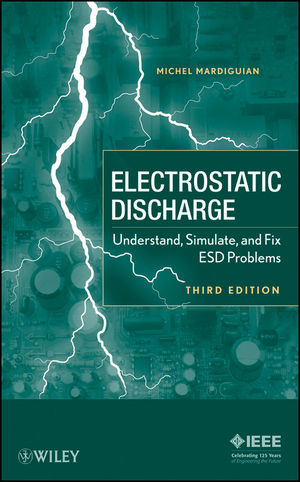Electro Static Discharge: Understand, Simulate, and Fix ESD Problems, 3rd EditionISBN: 978-0-470-39704-6
Hardcover
320 pages
September 2009, Wiley-IEEE Press
 This is a Print-on-Demand title. It will be printed specifically to fill your order. Please allow an additional 10-15 days delivery time. The book is not returnable.
|
||||||
Preface to the Third Edition.
Acknowledgements.
1. The Electrostatic Discharge Phenomenon.
1.1. Physics Involved.
1.2. Influencing Parameters.
1.3. Various Types of Electrostatic Charging with Humans and Objects.
1.4. Statistics of Voltages and Currents Reached During ESD.
1.5. Waveforms of Electrostatic Discharges.
References.
2. Effects of ESD on Electronics.
2.1. Direct Discharge to an Electronic Component.
2.2. Direct Discharge to Electronic Equipment Enclosure.
2.3. Indirect Discharge.
2.4. Coupling Mechanisms of ESD Pulse into the Victim’s Circuitry.
2.5. Response of Victim Circuits and Type of Errors.
2.6. Prediction of Actual ESD-Induced Error, Fast Approximation Method.
2.7. Remarks on the Actual Current Paths and Associated Radiation.
2.8. Personnel or Furniture ESD: Which One is Worse?
References.
3. Principal ESD Specifications.
3.1. ESD Test Specifications for Device Sensitivity.
3.2. ESD Specifications for Equipment Immunity.
3.3. Antistatic Control Procedures.
References.
4. ESD Diagnostics and Testing.
4.1. ESD Simulators: How They Work.
4.2. Furniture Versus Personnel ESD Simulation.
4.3. Other Types of ESD Simulators for Component Testing.
4.4. ESD Test Setup—Direct and Indirect ESD.
4.5. ESD Test Routine and Discharge Procedures.
4.6. No Error/No Damage Concept: The Several Layers of Severity.
4.7. The Error per Discharge Concept or Multiple-Trials Approach.
4.8. ESD Test During Design and Development.
4.9. ESD For Field Diagnostics and Forced Crash Method.
4.10. Home-Made Investigation Tools and Diagnostic Hints.
References.
5. Design for ESD Immunity.
5.1. ESD Protection at Component Level.
5.2. ESD Protection at the PCB Level (Internal Circuitry).
5.3. ESD Protection by Internal Wiring and Mechanical Packaging.
5.4. ESD Protection by Box Shielding and Envelope Design.
5.5. ESD Protection of External Cables and I/O Ports.
5.6. ESD Immunity by Software and Noise Inhibition Techniques.
5.7. ESD Immunity with Miniature, Portable Devices.
5.8. System ESD Immunity.
5.9. ESD Control at Installation Level.
References.
6. ESD Cases Studies.
6.1. Case 1: The Reradiating Ground Strap.
6.2. Case 2: ESD Hardening of a Printer.
6.3. Case 3: The Data Terminal with Floating Tray.
6.4. Case 4: The Safety Wire “Antenna”.
6.5. Case 5: The Touchy Watchdog.
6.6. Case 6: The Trigger-Happy Air bag Initiator.
6.7. Conclusion: Troubleshooting Hints.
Appendix A. ESD Protection by Design of Chips and Microcircuits.
Appendix B. Prediction of ESD Damage Level for a Semiconductor Junction.
Appendix C. Spark-Over Voltages.
Appendix D. Fatigue Phenomena During Repeated ESD Testing.
Appendix E. Prediction of ESD-Induced Noise by Fast Frequency- Domain Calculations.
Appendix F. More Experiments on ESD Coupling to Boxes.
Appendix G. Examples of Simple SPICE Modeling of ESD Coupling Effects.
Appendix H. Time-to-Frequency Conversion for a Single Transient.
Index.



